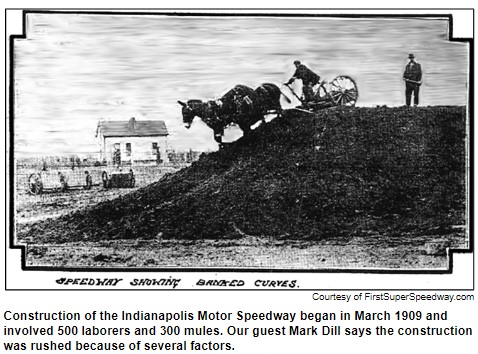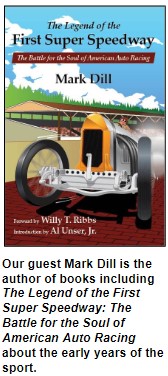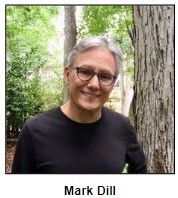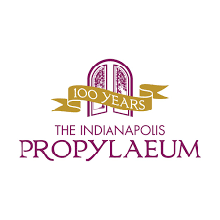A live weekly radio adventure through Indiana history with host Nelson Price. Airs live on Saturdays from noon to 1 pm ET at WICR 88.7 fm in Indianapolis.
You can listen to WICR anywhere on your mobile device or at home on your smart speaker. Go to www.wicronline.org to listen live. You can also ask your smart speaker to "play WICR" OR "play 88.7 the Diamond".
April 08, 2023
Construction of the Speedway in 1909 and pre-Indy 500 races

 As we varoom toward racing festivities, Hoosier History Live will shift into reverse gear for an exploration of the rapid construction of the Indianapolis Motor Speedway in 1909. We also will spotlight early auto races at the Speedway that year, including some tragedies that preceded the successful inaugural Indianapolis 500 in 1911.
As we varoom toward racing festivities, Hoosier History Live will shift into reverse gear for an exploration of the rapid construction of the Indianapolis Motor Speedway in 1909. We also will spotlight early auto races at the Speedway that year, including some tragedies that preceded the successful inaugural Indianapolis 500 in 1911.
 It took Speedway founder Carl Fisher and his partners about three years to acquire the property for the racetrack, according to our guest. Then, several factors resulted in a rush to get the Speedway built quickly. Beginning in March 1909, construction involved a total of 500 laborers and 300 mules.
It took Speedway founder Carl Fisher and his partners about three years to acquire the property for the racetrack, according to our guest. Then, several factors resulted in a rush to get the Speedway built quickly. Beginning in March 1909, construction involved a total of 500 laborers and 300 mules.
Nelson's guest will be Mark Dill, an acclaimed historian of early auto racing and the creator of FirstSuperSpeedway.com, an extensive online archive about pre-1920 auto racing. An Indy native and former vice president for marketing and public relations at the Indianapolis Motor Speedway, Mark is based in Cary, N.C., and is the author of books about the early era of auto racing, including The Legend of the First Super Speedway: The Battle for the Soul of American Auto Racing.
The first serious discussion about building a large Speedway occurred between entrepreneur Carl Fisher and his partners during an event in November 1905 at the Indiana State Fairgrounds, according to Mark. He describes Fisher (1874-1939) as a "massive risk taker".

 By all accounts, the initial auto races in 1909 at the racetrack (initially built of crushed stone) were a disaster. Multiple races on one weekend resulted, Mark notes, in five fatalities; one driver, two riding mechanics and two spectators were killed.
By all accounts, the initial auto races in 1909 at the racetrack (initially built of crushed stone) were a disaster. Multiple races on one weekend resulted, Mark notes, in five fatalities; one driver, two riding mechanics and two spectators were killed.
The tragedies outraged Indiana's lieutenant governor, Frank Hall, who urged the legislature to ban auto racing in the state. But the popular governor, Thomas R. Marshall, and business leaders defended the Speedway. Fisher and his partners funded a second major construction project to remove the crushed stone, replacing it by paving the racetrack with bricks. Before the paving project was even completed, 'The Brickyard' nickname for the racetrack had been coined, Mark Dill notes.
Mark has been a guest on previous Hoosier History Live shows about early auto racing. They include a show in 2016 about Hoosiers who competed in early Indy 500s and a follow-up two years later focusing on the international aspects of early Indy 500s.
International interest in auto racing apparently existed from the earliest years. According to Mark, the opening in 1907 of an oval race track in England was a factor in the push by Carl Fisher to complete the construction of the Speedway quickly. "He was competitive and hated any perception that anyone beat him at anything."
Fisher and his partners also wanted to recover their initial investment of more than $700,000 as quickly as possible, Mark says. In addition to the 500 laborers and 300 mules involved in the construction of the Speedway in 1909, several steam-powered excavators and rollers were used.
Some other history notes:
-
In 1997, our guest Mark Dill got to participate in the traditional milk-drinking celebration in victory circle at the Speedway by the winning Indy 500 team. He was working then for a business that he arranged to sponsor the car driven by Arie Luyendyk, who won the race.
-
As many racing trivia buffs know, the first major competition at the Speedway was a hot air balloon race in June 1909. Carl Fisher was among the competitors in the event, which Mark notes was held while the racetrack was still under construction.
- In May 1910, the first major auto event at The Brickyard was a race that extended over three days. The event, Mark says, "was a success in speed and safety". The winner was Ray Harroun, who drove the same Marmon Wasp that would go on to win the first Indy 500 in 1911. "Most people don’t know the Wasp was a one-year-old car when it won", Mark notes.

Your contributions help keep Hoosier History Live on the air, on the web and in your inbox!


 Why is Hoosier History Live an outstanding media product? Because we are independent, and we because we make our own business and editorial decisions. We control our quality as best we can. Basically, producer Molly Head makes the business decisions and manages the project. And, she created Hoosier History Live! Host Nelson Price selects and researches the main show topic and guest. And is, of course, the effervescent on-air talent. Where else are you going to learn about history and be entertained all at the same time?
Why is Hoosier History Live an outstanding media product? Because we are independent, and we because we make our own business and editorial decisions. We control our quality as best we can. Basically, producer Molly Head makes the business decisions and manages the project. And, she created Hoosier History Live! Host Nelson Price selects and researches the main show topic and guest. And is, of course, the effervescent on-air talent. Where else are you going to learn about history and be entertained all at the same time?
 Attorney
Attorney 





